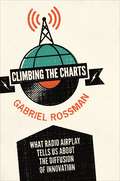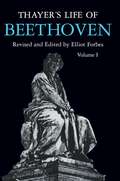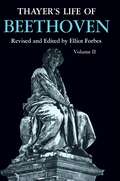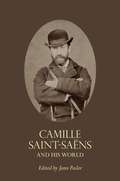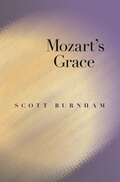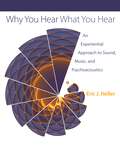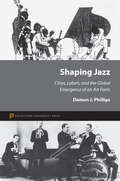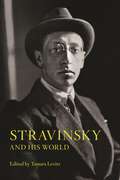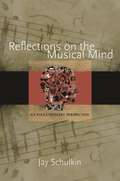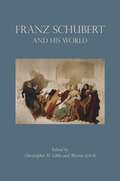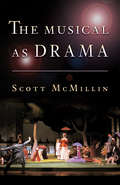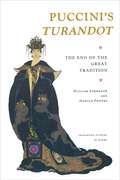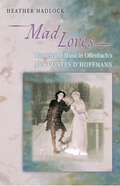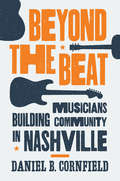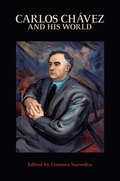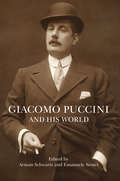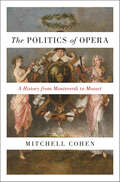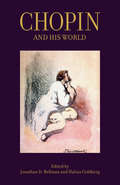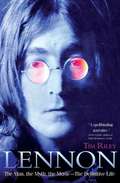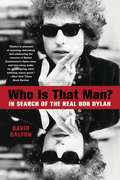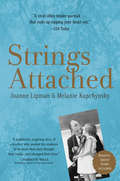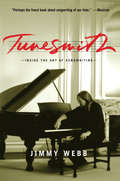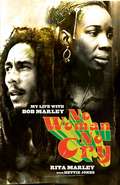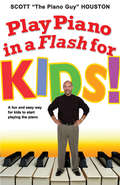- Table View
- List View
Climbing the Charts: What Radio Airplay Tells Us about the Diffusion of Innovation
by Gabriel RossmanHow songs achieve commercial success on the radioDespite the growth of digital media, traditional FM radio airplay still remains the essential way for musicians to achieve commercial success. Climbing the Charts examines how songs rise, or fail to rise, up the radio airplay charts. Looking at the relationships between record labels, tastemakers, and the public, Gabriel Rossman develops a clear picture of the roles of key players and the gatekeeping mechanisms in the commercial music industry. Along the way, he explores its massive inequalities, debunks many popular misconceptions about radio stations' abilities to dictate hits, and shows how a song diffuses throughout the nation to become a massive success.Contrary to the common belief that Clear Channel sees every sparrow that falls, Rossman demonstrates that corporate radio chains neither micromanage the routine decision of when to start playing a new single nor make top-down decisions to blacklist such politically inconvenient artists as the Dixie Chicks. Neither do stations imitate either ordinary peers or the so-called kingmaker radio stations who are wrongly believed to be able to make or break a single. Instead, Rossman shows that hits spread rapidly across radio because they clearly conform to an identifiable style or genre. Radio stations respond to these songs, and major labels put their money behind them through extensive marketing and promotion efforts, including the illegal yet time-honored practice of payoffs known within the industry as payola.Climbing the Charts provides a fresh take on the music industry and a model for understanding the diffusion of innovation.
Thayer's Life of Beethoven, Part I
by Elliot ForbesThe book description for the previously published "Thayer's Life of Beethoven" is not yet available.
Thayer's Life of Beethoven, Part II
by Elliot ForbesAlexander Wheelock Thayer's Life of Beethoven. has long been recognized as the classic biography of Beethoven. "Thayer, with his calm and logical mind, scrupulous, magnanimous and spacious...had set out to describe for posterity the great man as he was and lived...and his patient realism and all but inexhaustible industry had created an irreplaceable and masterly portrait." So Van Wyck Brooks described this monumental work of the 1880's.Thayer talked with Beethoven's surviving friends, gathered anecdotes, and sifted hundreds of documents. The resulting wealth of detail stimulated other students, and a mass of Beethoven scholarship appeared. Now Elliot Forbes, one of the foremost Beethoven scholars of our time, has used this new material to bring the Life up to elate without sacrificing Thayer's text.
Camille Saint-Saëns and His World (The Bard Music Festival #32)
by Jann PaslerA revealing look at French composer and virtuoso Camille Saint-SaënsCamille Saint-Saëns—perhaps the foremost French musical figure of the late nineteenth century and a composer who wrote in nearly every musical genre, from opera and the symphony to film music—is now being rediscovered after a century of modernism overshadowed his earlier importance. In a wide-ranging and trenchant series of essays, articles, and documents, Camille Saint-Saëns and His World deconstructs the multiple realities behind the man and his music. Topics range from intimate glimpses of the private and playful Saint-Saëns, to the composer's interest in astronomy and republican politics, his performances of Mozart and Rameau over eight decades, and his extensive travels around the world. This collection also analyzes the role he played in various musical societies and his complicated relationship with such composers as Liszt, Massenet, Wagner, and Ravel. Featuring the best contemporary scholarship on this crucial, formative period in French music, Camille Saint-Saëns and His World restores the composer to his vital role as innovator and curator of Western music.The contributors are Byron Adams, Leon Botstein, Jean-Christophe Branger, Michel Duchesneau, Katharine Ellis, Annegret Fauser, Yves Gérard, Dana Gooley, Carolyn Guzski, Carol Hess, D. Kern Holoman, Léo Houziaux, Florence Launay, Stéphane Leteuré, Martin Marks, Mitchell Morris, Jann Pasler, William Peterson, Michael Puri, Sabina Teller Ratner, Laure Schnapper, Marie-Gabrielle Soret, Michael Stegemann, and Michael Strasser.
Mozart's Grace
by Scott BurnhamAspects of beauty in the music of MozartIt is a common article of faith that Mozart composed the most beautiful music we can know. But few of us ask why. Why does the beautiful in Mozart stand apart, as though untouched by human hands? At the same time, why does it inspire intimacy rather than distant admiration, love rather than awe? And how does Mozart's music create and sustain its buoyant and ever-renewable effects? In Mozart's Grace, Scott Burnham probes a treasury of passages from many different genres of Mozart's music, listening always for the qualities of Mozartean beauty: beauty held in suspension; beauty placed in motion; beauty as the uncanny threshold of another dimension, whether inwardly profound or outwardly transcendent; and beauty as a time-stopping, weightless suffusion that comes on like an act of grace.Throughout the book, Burnham engages musical issues such as sonority, texture, line, harmony, dissonance, and timing, and aspects of large-scale form such as thematic returns, retransitions, and endings. Vividly describing a range of musical effects, Burnham connects the ways and means of Mozart's music to other domains of human significance, including expression, intimation, interiority, innocence, melancholy, irony, and renewal. We follow Mozart from grace to grace, and discover what his music can teach us about beauty and its relation to the human spirit. The result is a newly inflected view of our perennial attraction to Mozart's music, presented in a way that will speak to musicians and music lovers alike.
Why You Hear What You Hear: An Experiential Approach to Sound, Music, and Psychoacoustics
by Eric J. HellerA groundbreaking textbook that explores the phenomena and physics of music and soundWhy You Hear What You Hear is the first book on the physics of sound for the nonspecialist to empower readers with a hands-on, ears-open approach that includes production, analysis, and perception of sound. The book makes possible a deep intuitive understanding of many aspects of sound, as opposed to the usual approach of mere description. This goal is aided by hundreds of original illustrations and examples, many of which the reader can reproduce and adjust using the same tools used by the author (e.g., very accessible applets for PC and Mac, and interactive web-based examples, simulations, and analysis tools that can be found on the book's website: whyyouhearwhatyouhear.com). Readers are positioned to build intuition by participating in discovery.This truly progressive introduction to sound engages and informs amateur and professional musicians, performers, teachers, sound engineers, students of many stripes, and indeed anyone interested in the auditory world. The book does not hesitate to follow entertaining and sometimes controversial side trips into the history and world of acoustics, reinforcing key concepts. You will discover how musical instruments really work, how pitch is perceived, and how sound can be amplified with no external power source.Sound is key to our lives, and is the most accessible portal to the vibratory universe. This book takes you there.The first book on sound to offer interactive tools, building conceptual understanding via an experiential approachSupplementary website (http://www.whyyouhearwhatyouhear.com) provides Java, MAX, and other free, multiplatform, interactive graphical and sound appletsExtensive selection of original exercises available on the web with solutionsNearly 400 full-color illustrations, many of simulations that students can do
Shaping Jazz: Cities, Labels, and the Global Emergence of an Art Form
by Damon J. PhillipsThere are over a million jazz recordings, but only a few hundred tunes have been recorded repeatedly. Why did a minority of songs become jazz standards? Why do some songs--and not others--get rerecorded by many musicians? Shaping Jazz answers this question and more, exploring the underappreciated yet crucial roles played by initial production and markets--in particular, organizations and geography--in the development of early twentieth-century jazz.Damon Phillips considers why places like New York played more important roles as engines of diffusion than as the sources of standards. He demonstrates why and when certain geographical references in tune and group titles were considered more desirable. He also explains why a place like Berlin, which produced jazz abundantly from the 1920s to early 1930s, is now on jazz's historical sidelines. Phillips shows the key influences of firms in the recording industry, including how record companies and their executives affected what music was recorded, and why major companies would rerelease recordings under artistic pseudonyms. He indicates how a recording's appeal was related to the narrative around its creation, and how the identities of its firm and musicians influenced the tune's long-run popularity.Applying fascinating ideas about market emergence to a music's commercialization, Shaping Jazz offers a unique look at the origins of a groundbreaking art form.
Stravinsky and His World (The Bard Music Festival #33)
by Tamara LevitzA new look at one of the most important composers of the twentith centuryStravinsky and His World brings together an international roster of scholars to explore fresh perspectives on the life and music of Igor Stravinsky. Situating Stravinsky in new intellectual and musical contexts, the essays in this volume shed valuable light on one of the most important composers of the twentieth century.Contributors examine Stravinsky's interaction with Spanish and Latin American modernism, rethink the stylistic label "neoclassicism" with a section on the ideological conflict over his lesser-known opera buffa Mavra, and reassess his connections to his homeland, paying special attention to Stravinsky's visit to the Soviet Union in 1962. The essays also explore Stravinsky's musical and religious differences with Arthur Lourié, delve into Stravinsky's collaboration with Pyotr Suvchinsky and Roland-Manuel in the genesis of his groundbreaking Poetics of Music, and look at how the movement within stasis evident in the scores of Stravinsky's Orpheus and Oedipus Rex reflected the composer's fierce belief in fate. Rare documents—including Spanish and Mexican interviews, Russian letters, articles by Arthur Lourié, and rarely seen French and Russian texts—supplement the volume, bringing to life Stravinsky's rich intellectual milieu and intense personal relationships.The contributors are Tatiana Baranova, Leon Botstein, Jonathan Cross, Valérie Dufour, Gretchen Horlacher, Tamara Levitz, Klára Móricz, Leonora Saavedra, and Svetlana Savenko.
Reflections on the Musical Mind: An Evolutionary Perspective
by Jay SchulkinWhat's so special about music? We experience it internally, yet at the same time it is highly social. Music engages our cognitive/affective and sensory systems. We use music to communicate with one another--and even with other species--the things that we cannot express through language. Music is both ancient and ever evolving. Without music, our world is missing something essential.In Reflections on the Musical Mind, Jay Schulkin offers a social and behavioral neuroscientific explanation of why music matters. His aim is not to provide a grand, unifying theory. Instead, the book guides the reader through the relevant scientific evidence that links neuroscience, music, and meaning. Schulkin considers how music evolved in humans and birds, how music is experienced in relation to aesthetics and mathematics, the role of memory in musical expression, the role of music in child and social development, and the embodied experience of music through dance. He concludes with reflections on music and well-being. Reflections on the Musical Mind is a unique and valuable tour through the current research on the neuroscience of music.
Franz Schubert and His World (The Bard Music Festival #37)
by Christopher H. Gibbs and Morten SolvikThe life, times, and music of Franz SchubertDuring his short lifetime, Franz Schubert (1797–1828) contributed to a wide variety of musical genres, from intimate songs and dances to ambitious chamber pieces, symphonies, and operas. The essays and translated documents in Franz Schubert and His World examine his compositions and ties to the Viennese cultural context, revealing surprising and overlooked aspects of his music.Contributors explore Schubert's youthful participation in the Nonsense Society, his circle of friends, and changing views about the composer during his life and in the century after his death. New insights are offered about the connections between Schubert’s music and the popular theater of the day, his strategies for circumventing censorship, the musical and narrative relationships linking his song settings of poems by Gotthard Ludwig Kosegarten, and musical tributes he composed to commemorate the death of Beethoven just twenty months before his own. The book also includes translations of excerpts from a literary journal produced by Schubert’s classmates and of Franz Liszt’s essay on the opera Alfonso und Estrella. In addition to the editors, the contributors are Leon Botstein, Lisa Feurzeig, John Gingerich, Kristina Muxfeldt, and Rita Steblin.
The Musical as Drama
by H. Scott McMillinDerived from the colorful traditions of vaudeville, burlesque, revue, and operetta, the musical has blossomed into America's most popular form of theater. Scott McMillin has developed a fresh aesthetic theory of this underrated art form, exploring the musical as a type of drama deserving the kind of critical and theoretical regard given to Chekhov or opera. Until recently, the musical has been considered either an "integrated" form of theater or an inferior sibling of opera. McMillin demonstrates that neither of these views is accurate, and that the musical holds true to the disjunctive and irreverent forms of popular entertainment from which it arose a century ago. Critics and composers have long held the musical to the standards applied to opera, asserting that each piece should work together to create a seamless drama. But McMillin argues that the musical is a different form of theater, requiring the suspension of the plot for song. The musical's success lies not in the smoothness of unity, but in the crackle of difference. While disparate, the dancing, music, dialogue, and songs combine to explore different aspects of the action and the characters. Discussing composers and writers such as Rodgers and Hammerstein, Stephen Sondheim, Kander and Ebb, Leonard Bernstein, and Jerome Kern, The Musical as Drama describes the continuity of this distinctively American dramatic genre, from the shows of the 1920s and 1930s to the musicals of today.
Puccini's Turandot: The End of the Great Tradition (Princeton Studies in Opera #30)
by William Ashbrook Harold PowersUnfinished at Puccini's death in 1924, Turandot was not only his most ambitious work, but it became the last Italian opera to enter the international repertory. In this colorful study two renowned music scholars demonstrate that this work, despite the modern climate in which it was written, was a fitting finale for the centuries-old Great Tradition of Italian opera. Here they provide concrete instances of how a listener might encounter the dramatic and musical structures of Turandot in light of the Italian melodramma, and firmly establish Puccini's last work within the tradition of Rossini, Bellini, Donizetti, and Verdi. In a summary of the sounds, sights, and symbolism of Turandot, the authors touch on earlier treatments of the subject, outline the conception, birth, and reception of the work, and analyze its coordinated dramatic and musical design. Showing how the evolution of the libretto documents Puccini's reversion to large musical forms typical of the Great Tradition in the late nineteenth century, they give particular attention to his use of contrasting Romantic, modernist, and two kinds of orientalist coloration in the general musical structure. They suggest that Puccini's inability to complete the opera resulted mainly from inadequate dramatic buildup for Turandot's last-minute change of heart combined with an overly successful treatment of the secondary character.
Mad Loves: Women and Music in Offenbach's Les Contes d'Hoffmann (Princeton Studies in Opera #16)
by Heather HadlockIn a lively exploration of Jacques Offenbach's final masterpiece, Heather Hadlock shows how Les Contes d'Hoffmann summed up not only the composer's career but also a century of Romantic culture. A strange fusion of irony and profundity, frivolity and nightmare, the opera unfolds as a series of dreamlike episodes, peopled by such archetypes as the Poet, the Beautiful Dying Girl, the Automaton, the Courtesan, and the Mesmerist. Hadlock shows how these episodes comprise a collective unconscious. Her analyses touch on topics ranging from the self-reflexive style of the protagonist and the music, to parallels between nineteenth-century discourses of theater and medical science, to fascination with the hysterical female subject. Les Contes d'Hoffmann is also examined as both a continuation and a retraction of tendencies in Offenbach's earlier operettas and opéra-comiques. Hadlock investigates the political climate of the 1870s that influenced the composer's vision and the reception of his last work. Drawing upon insights from feminist, literary, and cultural theory, she considers how the opera's music and libretto took shape within a complex literary and theatrical tradition. Finally, Hadlock ponders the enigmas posed by the score of this unfinished opera, which has been completed many times and by many different hands since its composer's death shortly before the premiere in 1881. In this book, the "mad loves" that drive Les Contes d'Hoffmann--a poet's love, a daughter's love, erotic love, and fatal attraction to music--become figures for the fascination exercised by opera itself.
Beyond the Beat
by Daniel B. CornfieldAt a time when the bulwarks of the music industry are collapsing, what does it mean to be a successful musician and artist? How might contemporary musicians sustain their artistic communities? Based on interviews with over seventy-five popular-music professionals in Nashville, Beyond the Beat looks at artist activists--those visionaries who create inclusive artist communities in today's individualistic and entrepreneurial art world. Using Nashville as a model, Daniel Cornfield develops a theory of artist activism--the ways that artist peers strengthen and build diverse artist communities.Cornfield discusses how genre-diversifying artist activists have arisen throughout the late twentieth-century musician migration to Nashville, a city that boasts the highest concentration of music jobs in the United States. Music City is now home to diverse recording artists--including Jack White, El Movimiento, the Black Keys, and Paramore. Cornfield identifies three types of artist activists: the artist-producer who produces and distributes his or her own and others' work while mentoring early-career artists, the social entrepreneur who maintains social spaces for artist networking, and arts trade union reformers who are revamping collective bargaining and union functions. Throughout, Cornfield examines enterprising musicians both known and less recognized. He links individual and collective actions taken by artist activists to their orientations toward success, audience, and risk and to their original inspirations for embarking on music careers.Beyond the Beat offers a new model of artistic success based on innovating creative institutions to benefit the society at large.
Carlos Chavez and His World
by Leonora SaavedraCarlos Chávez (1899-1978) is the central figure in Mexican music of the twentieth century and among the most eminent of all Latin American modernist composers. An enfant terrible in his own country, Chávez was an integral part of the emerging music scene in the United States in the 1920s. His highly individual style--diatonic, dissonant, contrapuntal--addressed both modernity and Mexico's indigenous past. Chávez was also a governmental arts administrator, founder of major Mexican cultural institutions, and conductor and founder of the Orquesta Sinfónica de México. Carlos Chávez and His World brings together an international roster of leading scholars to delve into not only Chávez's music but also the history, art, and politics surrounding his life and work.Contributors explore Chávez's vast body of compositions, including his piano music, symphonies, violin concerto, late compositions, and Indianist music. They look at his connections with such artistic greats as Aaron Copland, Miguel Covarrubias, Henry Cowell, Silvestre Revueltas, and Paul Strand. The essays examine New York's modernist scene, Mexican symphonic music, portraits of Chávez by major Mexican artists of the period, including Diego Rivera and Rufino Tamayo, and Chávez's impact on El Colegio Nacional. A quantum leap in understanding Carlos Chávez and his milieu, this collection will stimulate further work in Latin American music and culture.The contributors are Ana R. Alonso-Minutti, Amy Bauer, Leon Botstein, David Brodbeck, Helen Delpar, Christina Taylor Gibson, Susana González Aktories, Anna Indych-López, Roberto Kolb-Neuhaus, James Krippner, Rebecca Levi, Ricardo Miranda, Julián Orbón, Howard Pollack, Leonora Saavedra, Antonio Saborit, Stephanie Stallings, and Luisa Vilar Payá.Bard Music Festival 2015:Carlos Chávez and His WorldBard CollegeAugust 7-9 and August 14-16, 2015
Giacomo Puccini and His World
by Emanuele Senici Arman SchwartzGiacomo Puccini (1858-1924) is the world's most frequently performed operatic composer, yet he is only beginning to receive serious scholarly attention. In Giacomo Puccini and His World, an international roster of music specialists, several writing on Puccini for the first time, offers a variety of new critical perspectives on the composer and his works. Containing discussions of all of Puccini's operas from Manon Lescaut (1893) to Turandot (1926), this volume aims to move beyond clichés of the composer as a Romantic epigone and to resituate him at the heart of early twentieth-century musical modernity. This collection's essays explore Puccini's engagement with spoken theater and operetta, and with new technologies like photography and cinema. Other essays consider the philosophical problems raised by "realist" opera, discuss the composer's place in a variety of cosmopolitan formations, and reevaluate Puccini's orientalism and his complex interactions with the Italian fascist state. A rich array of primary source material, including previously unpublished letters and documents, provides vital information on Puccini's interactions with singers, conductors, and stage directors, and on the early reception of the verismo movement. Excerpts from Fausto Torrefranca's notorious Giacomo Puccini and International Opera, perhaps the most vicious diatribe ever directed against the composer, appear here in English for the first time. The contributors are Micaela Baranello, Leon Botstein, Alessandra Campana, Delia Casadei, Ben Earle, Elaine Fitz Gibbon, Walter Frisch, Michele Girardi, Arthur Groos, Steven Huebner, Ellen Lockhart, Christopher Morris, Arman Schwartz, Emanuele Senici, and Alexandra Wilson.
The Politics of Opera: A History from Monteverdi to Mozart
by Mitchell CohenA wide-ranging look at the interplay of opera and political ideas through the centuriesThe Politics of Opera takes readers on a fascinating journey into the entwined development of opera and politics, from the Renaissance through the turn of the nineteenth century. What political backdrops have shaped opera? How has opera conveyed the political ideas of its times? Delving into European history and thought and an array of music by such greats as Lully, Rameau, and Mozart, Mitchell Cohen reveals how politics—through story lines, symbols, harmonies, and musical motifs—has played an operatic role both robust and sotto voce.Cohen begins with opera's emergence under Medici absolutism in Florence during the late Renaissance—where debates by humanists, including Galileo's father, led to the first operas in the late sixteenth century. Taking readers to Mantua and Venice, where composer Claudio Monteverdi flourished, Cohen examines how early operatic works like Orfeo used mythology to reflect on governance and policy issues of the day, such as state jurisdictions and immigration. Cohen explores France in the ages of Louis XIV and the Enlightenment and Vienna before and during the French Revolution, where the deceptive lightness of Mozart's masterpieces touched on the havoc of misrule and hidden abuses of power. Cohen also looks at smaller works, including a one-act opera written and composed by philosopher Jean-Jacques Rousseau. Essential characters, ancient and modern, make appearances throughout: Nero, Seneca, Machiavelli, Mazarin, Fenelon, Metastasio, Beaumarchais, Da Ponte, and many more.An engrossing book that will interest all who love opera and are intrigued by politics, The Politics of Opera offers a compelling investigation into the intersections of music and the state.
Chopin and His World
by Jonathan D. Bellman Halina GoldbergA new look at the life, times, and music of Polish composer and piano virtuoso Fryderyk ChopinFryderyk Chopin (1810–49), although the most beloved of piano composers, remains a contradictory figure, an artist of virtually universal appeal who preferred the company of only a few sympathetic friends and listeners. Chopin and His World reexamines Chopin and his music in light of the cultural narratives formed during his lifetime. These include the romanticism of the ailing spirit, tragically singing its death-song as life ebbs; the Polish expatriate, helpless witness to the martyrdom of his beloved homeland, exiled among friendly but uncomprehending strangers; the sorcerer-bard of dream, memory, and Gothic terror; and the pianist's pianist, shunning the appreciative crowds yet composing and improvising idealized operas, scenes, dances, and narratives in the shadow of virtuoso-idol Franz Liszt. The international Chopin scholars gathered here demonstrate the ways in which Chopin responded to and was understood to exemplify these narratives, as an artist of his own time and one who transcended it. This collection also offers recently rediscovered artistic representations of his hands (with analysis), and—for the first time in English—an extended tribute to Chopin published in Poland upon his death and contemporary Polish writings contextualizing Chopin's compositional strategies. The contributors are Jonathan D. Bellman, Leon Botstein, Jean-Jacques Eigeldinger, Halina Goldberg, Jeffrey Kallberg, David Kasunic, Anatole Leikin, Eric McKee, James Parakilas, John Rink, and Sandra P. Rosenblum. Contemporary documents by Karol Kurpiński, Adam Mickiewicz, and Józef Sikorski are included.
Lennon: The Man, the Myth, the Music - The Definitive Life
by Tim RileyIn his commanding new book, the eminent NPR critic Tim Riley takes us on the remarkable journey that brought a Liverpool art student from a disastrous childhood to the highest realms of fame.Riley portrays Lennon's rise from Hamburg's red light district to Britain's Royal Variety Show; from the charmed naiveté of "Love Me Do" to the soaring ambivalence of "Don't Let Me Down"; from his shotgun marriage to Cynthia Powell in 1962 to his epic media romance with Yoko Ono. Written with the critical insight and stylistic mastery readers have come to expect from Riley, this richly textured narrative draws on numerous new and exclusive interviews with Lennon's friends, enemies, confidantes, and associates; lost memoirs written by relatives and friends; as well as previously undiscovered City of Liverpool records. Riley explores Lennon in all of his contradictions: the British art student who universalized an American style, the anarchic rock 'n' roller with the moral spine, the anti-jazz snob who posed naked with his avant-garde lover, and the misogynist who became a househusband. What emerges is the enormous, seductive, and confounding personality that made Lennon a cultural touchstone.In Lennon, Riley casts Lennon as a modernist hero in a sweeping epic, dramatizing rock history anew as Lennon himself might have experienced it.
Who Is That Man?: In Search of the Real Bob Dylan
by David DaltonFor the First Time in Paperback with a New Foreword, is a Kaleidoscopic Look at the Many Faces of Bob DylanFor almost half a century, Bob Dylan has been a primary catalyst in rock's shifting sensibilities. Few American artists are as important, beloved, and endlessly examined, yet he remains something of an enigma. Who, we ask, is the "real" Bob Dylan? Is he Bobby Zimmerman, yearning to escape Hibbing, Minnesota, or the Woody Guthrie wannabe playing Greenwich Village haunts? Folk Messiah, Born-Again Bob, Late-Elvis Dylan, Jack Fate, or Living National Treasure? In Who Is That Man?, timed for Dylan's 75th birthday, David Dalton--cultural historian, journalist, screenwriter, and novelist--paints a revealing portrait of the rock icon, ingeniously exposing the three-card monte games he plays with his persona.Guided by Dalton's cutting-edge insights and myth-debunking point of view, Who Is That Man? follows Dylan's imaginative life, integrating actual events with Dylan's words and those of the people who know him most intimately. Drawing upon Dylan's friends and fellow eyewitnesses--including Marianne Faithfull, Allen Ginsberg, Peter Stampfel , Larry "Ratso" Sloman, Eric Andersen, Nat Hentoff, Andrew Oldham, Nat Finkelstein, and others--this book will provide a new perspective on the man, the myth, and the musical era that forged them both.that you find a book in which the music is discussed as adroitly as any aspect of the life... Dalton is a penetrating critic."--Colin Fleming, Washington Post "Addictive reading... This approach would have crumbled in lesser hands, but Dalton does a stunningly good job."--Publishers Weekly, starred review "The mysteries of Bob Dylan captured in even-handed, never-boring fashion... This lively and literate attempt to read a half-century's worth of brain scans from a literal living legend strikes the right balance between admiration and skepticism."--Kirkus Reviews "All David Dalton's books are wonderful, but Who Is That Man? is especially insightful, funny, and beautifully written."--Marianne Faithfull "Dalton's crazy poetic prose first caught my eye in Rolling Stone back in the day. Have loved his writing ever since. Oh yeaah!"--Steven Tyler "The first truly hip analysis of the ultimate hipster." --Lenny Kaye
Heavier Than Heaven: A Biography of Kurt Cobain
by Charles R. CrossIt has been twenty years since Kurt Cobain died by his own hand in April 1994; it was an act of will that typified his short, angry, inspired life. Veteran music journalist Charles R. Cross fuses his intimate knowledge of the Seattle music scene with his deep compassion for his subject in this extraordinary story of artistic brilliance and the pain that extinguished it. Based on more than four hundred interviews; four years of research; exclusive access to Cobain's unpublished diaries, lyrics, and family photos; and a wealth of documentation, Heavier Than Heaven traces Cobain's life from his early days in a double-wide trailer outside of Aberdeen, Washington, to his rise to fame, success, and the adulation of a generation. Charles Cross has written a preface for this new edition, in which he recounts some of the events regarding Kurt Cobain and this book in the past two decades since his death.Cobain's health struggles and his tragic final days. More than the history of a rock and roll star, Heavier Than Heaven is a portrait of creative genius and the will to turn pain into art.
Strings Attached: One Tough Teacher And The Art Of Perfection
by Joanne Lipman Melanie KupchynskyStrings Attached is a powerful memoir about resilience in the face of unspeakable tragedy, an inspiring and poignant tale of how one man transformed his own heartache into a legacy of joy for his students. His students knew Jerry Kupchynsky as "Mr. K"-the fierce Ukrainian-born music teacher who rehearsed them until their fingers almost bled and who made them better than they ever expected to be. Away from the classroom, though, life seemed to conspire against him at every turn. Strings Attached takes you on his remarkable journey, from his childhood on the run in Nazi Germany, to his life in America caring for his disabled wife while raising their two small daughters, to his search for his beloved younger daughter after she mysteriously disappeared-a search that would last for seven years. His unforgettable story is lyrically told in alternating chapters by two childhood friends who reconnected decades later: Melanie Kupchynsky, his daughter, and Joanne Lipman, a former student. Heartbreaking yet ultimately triumphant, Strings Attached is a testament to the astonishing power of hope-and a celebration of the profound impact one person can have on the lives of others.
Tunesmith: Inside the Art of Songwriting
by Jimmy WebbWebb brings his insider's knowledge, experience, and star power to the ultimate guide for aspiring songwriters. With a combination of anecdotes, meditation, and advice, he breaks down the creative process from beginning to end--from coping with writer's block, to song construction, chords, and even self-promotion. Webb also gives readers a glimpse into the professional music world.
No Woman No Cry: My Life with Bob Marley
by Rita MarleyA memoir by the woman who knew Bob Marley best--his wife, Rita.Rita Marley grew up in the slums of Trench Town, Jamaica. Abandoned by her mother at a very young age, she was raised by her aunt. Music ran in Rita's family, and even as a child her talent for singing was pronounced. By the age of 18, Rita was an unwed mother, and it was then that she met Bob Marley at a recording studio in Trench Town. Bob and Rita became close friends, fell in love, and soon, she and her girlfriends were singing backup for the Wailers. At the ages of 21 and 19, Bob and Rita were married.The rest is history: Bob Marley and the Wailers set Jamaica and the world on fire. But while Rita displayed blazing courage, joy, and an indisputable devotion to her husband, life with Bob was not easy. There were his liaisons with other women--some of which produced children and were conducted under Rita's roof. The press repeatedly reported that Bob was unmarried to preserve his "image." But Rita kept her self-respect, and when Bob succumbed to cancer in 1981, she was at his side. In the years that followed, she became a force in her own right--as the Bob Marley Foundation's spokesperson and a performer in her reggae group, the I-Three.Written with author Hettie Jones, No Woman No Cry is a no-holds-barred account of life with one of the most famous musicians of all time. In No Woman No Cry, readers will learn about the never-before-told details of Bob Marley's life, including: How Rita practiced subsistence farming when first married to Bob to have food for her family. How Rita rode her bicycle into town with copies of Bob's latest songs to sell. How Rita worked as a housekeeper in Delaware to help support her family when her children were young. Why Rita chose to befriend some of the women with whom Bob had affairs and to give them advice on rearing the children they had with Bob. The story of the attack on Bob which almost killed the two of them. Bob's last wishes, dreams, and hopes, as well as the details of his death, such as who came to the funeral (and who didn't).
Play Piano in a Flash for Kids!: A Fun and Easy Way for Kids to Start Playing the Piano
by Scott HoustonGetting a child to play piano has never been easier!As seen on public television nationwide, Scott "The Piano Guy" Houston is the leading authority on fast and fun piano instruction. In Play Piano in a Flash for Kids! he simplifies his unique and effective method of learning to play piano, making it accessible to even the youngest want-to-be pianists. Highlighting popular, not classical, music, this book fosters and nourishes an early love for music by giving children the tools to play their favorite popular songs.Your child will be able to: Learn the basics of piano playing using a simple technique that pros use, which focuses on becoming a good player versus becoming a good notation reader Use easy-to-follow step-by-step illustrations that demonstrate each stage of learning Play popular music on the piano without having to learn how to read complicated sheet musicIt is a great book for kids who may have taken lessons previously but became frustrated by the long and complicated process. And all at a fraction of the cost of piano lessons!Both parents and children can have fun learning the piano or keyboard together, or children can work through the book on their own, with parents providing support only when needed. Play Piano in a Flash for Kids! is the perfect tool for parents or teachers to help their kids learn to play the piano quickly and easily.
